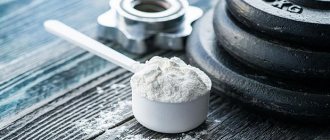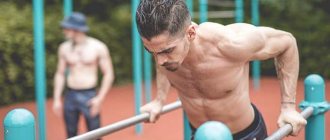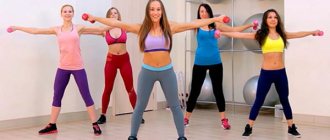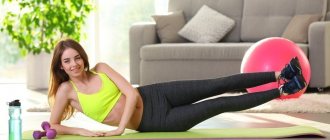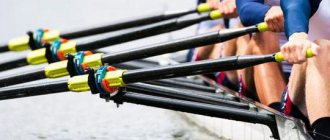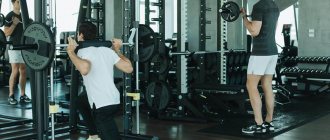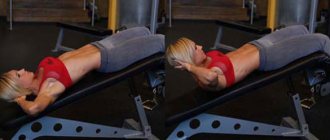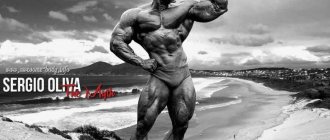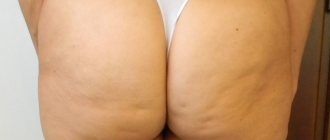Body sculpt group strength class is a fairly common trend in the world of fitness. However, despite the fact that this is a subtype of a complex of strength classes for working out the whole body, it is body sculpting that is more often included in the club schedule as a separate direction. What is it and what are the features of training, which is, in the literal sense, a “sculptor” of the body. Let's look at the advantages and disadvantages of such activities, as well as the main elements and visual video lessons of this area.
Body sculpt - what is it in fitness?
Body sculpting is a group fitness trend that includes both an aerobic part and a strength part, in which all the muscles of the body are worked out in one workout. Like classical aerobics, body sculpting is performed to rhythmic music, and sets of exercises are developed and demonstrated by a trainer. This is an effective workout for the consciousness of a toned and sculpted body.
A special feature of the training is the alternation of intense and less intense exercises to ensure alternate tension and relaxation of the muscles, which gives a noticeable effect, without the consequences of overtraining.
The training consists of four parts:
- Warm up. It is performed in the form of dynamic load and basic aerobics steps, like most strength classes.
- Cardio load. In this part of the workout, cardiovascular endurance is trained through aerobic exercises - combinations of step aerobics, jumping rope, and the like.
- Power part. Includes strength exercises with all kinds of fitness equipment, helps to work out all muscle groups.
- Stretching. This part of the cool-down prepares the muscles for subsequent rest and recovery, and also calms the nervous system.
Other directions[edit | edit code]
Many fitness clubs are increasingly using sports and gaming areas where you can play tennis, basketball, football, squash, etc.
Recently, special programs for women have been offered: classes for pregnant women and rehabilitation classes in the postpartum period. Scientists have shown the positive impact of special training at such important, special moments in women’s lives.
Fitness also plays a big role in effective daily activities. A person must also have special skills: carry objects, move correctly, perform various operations with the help of arms and legs. The recently launched programs “Functional Training” and “CrossFit” make it possible to solve these problems.
Thus, modern fitness allows you to solve the problems of a healthy lifestyle.
Rhythmic-plastic direction[edit | edit code]
The basis of most fitness programs
lies the gymnastic systems that arose at the turn of the nineteenth and twentieth centuries.
These include rhythmic-plastic directions
, Müller breathing gymnastics, athletic Sandow, Sokol gymnastics, etc.
A great contribution to the development of health-improving areas of gymnastics was made by the French physiologist Georges Demeny and the French theorist of performing arts and teacher Francois Delsarte. Demeny believed that physical exercise should be dynamic
, and not static, occur with large amplitude. With the popularity of this direction, built on free plastic movements, the means of gymnastics have expanded significantly. The works of Delsarte and his followers formed the basis of the theory of expressive movement and influenced the development of ballet and pantomime, serving as the foundation for the creation of one of the directions in gymnastics—rhythmoplastic. Increased interest in gymnastics was also caused by the emergence of a school of rhythmic gymnastics, founded by Jacques Dalcroze in 1910 in the small town of Hellerau near Dresden. It was he who first introduced the term “rhythmic gymnastics”. The system of rhythmic gymnastics was intended to develop musicians' hearing and sense of rhythm. However, along the way it turned out that it is very suitable as a means of physical education. The organic combination of music and movement is the basis of the Dalcroze method.
In connection with the creation and development of the rhythmic gymnastics system, one more name should be mentioned. This is Carl Orff. His system of children's gymnastics is aimed at the simultaneous development of physical qualities and, through the play method, creative abilities.
Gymnastics systems did not pay special attention to women. They performed the same exercises as men, without taking into account their physiological characteristics. And only in 1920-1930. Genevieve Stebbins and her follower Bess Mensendieck, under the influence of Swedish functional gymnastics and the J. Demeny system, developed methods to cultivate good posture, beautiful gait, and expressive movements in women.
Pilates[edit | edit code]
Main article:
Pilates exercises for beginners
At the beginning of the last century, another popular health improvement system was developed, which is based on conditioning exercises. This is the Pilates system, which is very popular nowadays. Pilates training method
was developed about a hundred years ago by Joseph Pilates and later named after him. Pilates classes tone muscles, develop balance, and improve physique. The Pilates system teaches conscious control over the execution of movements, learning self-control, mastering the ability to feel your body, muscles, and relax. The exercises are aimed at relieving excess tension, cultivating grace in movements, ease, and harmony of movements. Many other methods of physical improvement are built on the same theoretical basis. In particular, the system of M. Alexander and M. Feldenkrais. With over 90 years of historical success, the Pilates method has given a new impetus to the development of fitness at a time when the fitness industry has reached a dead end in creating new directions. Thanks to the active development and some modernization of the Pilates method, dissatisfaction with traditional programs, the last 10 years have seen a new rise in interest in health training methods in the unbroken chain of body, soul and mind - mental fitness (Body&Mind). Eastern health systems also belong to mental fitness.
Yoga[edit | edit code]
Main article:
Anatomy of yoga
Eastern practices of healing through physical culture are closely related to mentality, meditation, relaxation, contemplation, and visualization. Among Eastern practices, two main, most important areas should be highlighted: yoga
, whose homeland is India, and Chinese health systems.
The history of yoga goes back thousands of years.
The first images of yogis are found around 2000 century. BC. Yoga is closely related to one of the six philosophical doctrines of India - Sankhya, which is based on a doctrine called cosmology, the doctrine of the transmigration of souls. The first written evidence of this teaching appears in the earliest literary and historical monuments of India - in the Vedas and Upanishads, and then in the ancient Indian epic "Mahabharata", in the "Bhagavad Gita" section. The main provisions of the teachings of yogis are set out in the “Yoga Sutra” of Patanjali (approximately 200 century BC). Yoga plays a big role in the development of the internal organic body, instilling culture in it, as well as coordination of the physical body and mind.
Chinese health systems[edit | edit code]
The basis of Chinese physical education and health systems
lies Chinese philosophy and medicine. One of the most popular types of wushu gymnastics is taijiquan. The term tai chi does not simply refer to a system of physical exercises. It comes from the ancient Chinese philosophy of Taoism. Tao means “road”, “path” - a universal concept that implies conscious thought and participation. "Qi" (ji) can be translated as "vital energy" or "primary life force", and "tai" means "great", "huge". Thus, taiji is a way to find your own path in life, the “great limit”, “the pole of human possibilities”.
Chinese qigong gymnastics
- one of the most ancient health systems that have come down to us from time immemorial, used for the prevention and treatment of various diseases. Qigong is a system of training the mind and body with the goal of developing “true qi,” which allows you to mobilize the body’s reserves to improve health and prolong life. Qigong gymnastics includes a set of classes on concentration of one’s consciousness, motor and breathing exercises, the purpose of which is: accumulation of vital energy Qi, saturation of internal organs and systems with this energy, restoration of proper circulation of Qi in the body. When the energy balance in the body is normalized, a consistent correction of all its organs and functional systems occurs.
Aerobics[edit | edit code]
Main article:
Aerobics
Aerobics
- a concept that quite succinctly and accurately reflects the essence of aerobic health training, which is an excellent means of increasing the overall performance of the body. The aerobic nature of exercises such as running, swimming, skiing, and cycling gives them a special health value. Currently, the United States holds a leading position in the fitness industry, both in the production of equipment and clothing, as well as in the field of fitness services and the number of fitness clubs.
Kettlebell fitness[edit | edit code]
Main article:
Kettlebell fitness
Kettlebell fitness
- this is a direction that can be formulated as a set of exercises performed cyclically, mainly in an aerobic-anaerobic mode, aimed at working out the main muscle groups of the body.
The history of body sculpting training
The history of the emergence of this type of fitness is quite banal, first classical aerobics appeared, and then its types developed: the choreography became more complex and step platforms were added. But over time, fitness instructors began to look for an alternative to aerobic classes, which were not so effective for muscle development, and various strength classes began to appear, including body sculpting.
But do not confuse body sculpting with super sculpting; the latter is the basis of strength training for the whole body, the variety of which includes body sculpting.
Content
- 1 Characteristics of various modern fitness programs 1.1 Fitness training in the gym
- 1.2 Group cardio training
- 1.3 “Cyclic” aerobics
- 1.4 Strength training and aerobics
- 1.5 Programs with elements of oriental martial arts
- 1.6 Dance aerobics
- 1.7 Coordination training
- 1.8 Flexibility programs
- 1.9 Mind body programs
- 1.10 Combined types of aerobics
- 1.11 Regulated programs
- 2.1 Rhythmic-plastic direction
The benefits and harms of body sculpting training
Pros and benefits of training:
- Harmonious development of all muscle groups in one session.
- Including both strength and cardio exercises that help increase endurance, strengthen the heart and blood vessels, lose weight, and tone all muscles and ligaments.
- Increases metabolic rate.
- Training increases the flexibility of the body, while simultaneously strengthening and stretching the ligamentous apparatus.
- Strengthens the musculoskeletal system as a whole, increasing joint mobility.
Disadvantages and possible harm:
- The degree of load is quite intense, so it is not recommended for physically unprepared people, children, as well as after recent injuries and operations, since such loads can be harmful to health. Therefore, training is recommended for physically and mentally healthy people.
- Excess weight, although body sculpting training is aimed at losing weight, in case of obesity they are still contraindicated, since a high load on the heart and joints can provoke the development of heart diseases and deterioration in the functions of the musculoskeletal system.
- The direction should not be considered as a way to increase muscle mass, although muscle tone and volume increases, impressive hypertrophy cannot be achieved with aerobic exercise.
A set of body sculpting exercises for weight loss
The workout should last no more than one hour, performing all parts of the workout sequentially. Any available equipment can be used.
First part - warm-up
It is carried out in the form of running, jumping rope or basic aerobics steps for 7-10 minutes.
Aerobic part
For 20 minutes, perform jumping rope, alternating with crunches for the abdominal muscles in the following sequence:
- Jumping – 2 minutes.
- Lying body crunches – 30 seconds.
Perform 8 circles and at the end, stretch the muscles of your legs and torso.
Read more about post-workout stretching →
Power section
The exercises are performed one after another without rest for 20-25 repetitions. Let's take dumbbell training as an example. For the muscles of the legs and back, heavier dumbbells are needed, for the shoulder girdle - lighter ones.
Squats
- Place your feet wider than shoulder-width apart, with your toes pointing out to the sides.
- Place the dumbbells on your upper thighs under your ilia, holding them firmly with your hands.
- Squat until your thighs are parallel to the floor, moving your pelvis back, but keep the dumbbells in the same position.
Read more about squats with dumbbells →
Standing press
Less intense recovery exercise.
- Immediately after squats, take smaller dumbbells and lift them above your shoulders, pointing your elbows toward the floor.
- As you exit, fully straighten your arms above your head and smoothly return the dumbbells down.
Read more about standing dumbbell press →
Lunges forward alternately
Take heavy dumbbells in both hands, if necessary, place your feet together and perform lunges with your feet alternately forward, keeping your knees at a right angle when lunging.
More about lunges →
Dumbbell rows
Using the same dumbbells, perform bent-over rows.
- Bend your knees, lean forward with a straight back and lower your arms freely.
- As you exhale, pull the dumbbells to your waist, pressing your elbows to your torso, and slowly lower them as you inhale.
Read more about belt traction →
Romanian deadlift
- Hold one or two dumbbells in both hands.
- Place your feet shoulder-width apart.
- Bend your knees and inhale as you lean forward, lowering the dumbbells along your shins.
- Inhale as you rise.
Don't squat, it's important to stretch your hamstrings.
Read more about the Romanian deadlift →
Standing dumbbell fly
Using small dumbbells, perform arm raises while standing to the sides. At the same time, keep your elbows slightly bent, and when raising your arms from the bottom up, turn your hand with your little finger towards the ceiling.
Read more about dumbbell side swings →
Push ups
Perform regular push-ups from the floor, you can also simplify the exercise by performing it from your knees or on a hill.
Read more about push-ups →
Bending arms alternately
Perform the biceps exercise with your wrists turned at the top point. Bend your arms alternately without swaying your body. Press your elbows towards your body.
Read more about dumbbell curls →
At the end of the complex, stretch all muscle groups for 5-10 minutes.
Detailed implementation and variations of body sculpt training can be seen in the video lessons:
